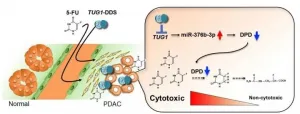"This scientific statement provides the most recent research and information on the relationship between obesity and obesity treatment in coronary heart disease, heart failure and arrhythmias," said Tiffany M. Powell-Wiley, M.D., M.P.H., FAHA, chair of the writing committee and a Stadtman Tenure-Track Investigator and chief of the Social Determinants of Obesity and Cardiovascular Risk Laboratory in the Division of Intramural Research at the National Heart, Lung, and Blood Institute at the National Institutes of Health in Bethesda, Maryland. "The timing of this information is important because the obesity epidemic contributes significantly to the global burden of cardiovascular disease and numerous chronic health conditions that also impact heart disease."
A greater understanding of obesity and its impact on cardiovascular health highlights abdominal obesity, sometimes referred to as visceral adipose tissue, or VAT, as a cardiovascular disease risk marker. VAT is commonly determined by waist circumference, the ratio of waist circumference to height (taking body size into account) or waist-to-hip ratio, which has been shown to predict cardiovascular death independent of BMI.
Experts recommend both abdominal measurement and BMI be assessed during regular health care visits because a high waist circumference or low waist-to-hip ratio, even in healthy weight individuals, could mean an increased risk of heart disease. Abdominal obesity is also linked to fat accumulation around the liver that often leads to non-alcoholic fatty liver disease, which adds to cardiovascular disease risk.
"Studies that have examined the relationship between abdominal fat and cardiovascular outcomes confirm that visceral fat is a clear health hazard," said Powell-Wiley.
The risk-inducing power of abdominal obesity is so strong that in people who are overweight or have obesity based on BMI, low levels of fat tissue around their midsection and organs could still indicate lower cardiovascular disease risks. This concept, referred to as "metabolically healthy obesity," seems to differ depending on race/ethnicity and sex.
Worldwide, around 3 billion people are overweight (BMI = 25 to 29.9 kg/m2) or have obesity obese(BMI ?30 kg/m2). Obesity is a complex disease related to many factors, including biologic, psychological, environmental and societal aspects, all of which may contribute to a person's risk for obesity. Obesity is associated with greater risk of coronary artery disease and death due to cardiovascular disease and contributes to many cardiovascular risk factors and other health conditions, including dyslipidemia (high cholesterol), type 2 diabetes, high blood pressure and sleep disorders.
For this statement, experts evaluated research on managing and treating obesity, particularly abdominal obesity. The writing group reports that reducing calories can reduce abdominal fat, and the most beneficial physical activity to reduce abdominal obesity is aerobic exercise. Their analysis found that meeting the current recommendations of 150 min/week of physical activity may be sufficient to reduce abdominal fat, with no additional loss from longer activity times. Exercise or a combination of dietary change and physical activity has been shown in some instances to reduce abdominal obesity even without weight loss.
Lifestyle changes and subsequent weight loss improve blood sugar, blood pressure, triglyceride and cholesterol levels - a cluster of factors referred to as metabolic syndrome - and reduce inflammation, improve blood vessel function and treat non-alcoholic fatty liver disease. However, studies of lifestyle change programs have not shown a reduction in coronary artery disease events (such as heart attack or chest pain).
In contrast, bariatric surgery for weight loss treatment is associated with a reduction in coronary artery disease risk compared to non-surgical weight loss. This difference may be attributed to the larger amount of weight loss and the resultant changes in metabolism that are typical after bariatric surgery.
"Additional work is needed to identify effective interventions for patients with obesity that improve cardiovascular disease outcomes and reduce cardiovascular disease mortality, as is seen with bariatric surgery," said Powell-Wiley.
The statement also addresses the "obesity paradox," which is sometimes observed in research, particularly in populations that have overweight or have Class I obesity (BMI = 30 to 34.9 kg/m2). The paradox suggests that even though overweight and obesity are strong risk factors for the development of cardiovascular disease, they are not always a risk factor for negative cardiovascular outcomes. The writing group notes that people with overweight or obesity are often screened earlier for cardiovascular disease than people with healthy weight, thus resulting in earlier diagnoses and treatment.
"The underlying mechanisms for the obesity paradox remain unclear," said Powell-Wiley. "Despite the existence of the paradox for short-term cardiovascular disease outcomes, the data show that patients with overweight or obesity suffer from cardiovascular disease events at an earlier age, live with cardiovascular disease for more of their lives and have a shorter average lifespan than patients with normal weight."
In reviewing the effects of obesity on a common heart rhythm disorder, the writing group reports there is now "convincing data" that obesity may cause atrial fibrillation, a quivering or irregular heartbeat. Estimates suggest obesity may account for one-fifth of all atrial fibrillation cases and 60% of recently documented increases in people with atrial fibrillation. Research has demonstrated people with atrial fibrillation who had intense weight loss experienced a significant reduction in cumulative time spent in atrial fibrillation.
"The research provides strong evidence that weight management be included as an essential aspect of managing atrial fibrillation, in addition to the standard treatments to control heart rate, rhythm and clotting risk," said Powell-Wiley.
The statement identifies areas of future research, including a call for further study of lifestyle interventions that may be most effective in decreasing visceral adiposity and improving cardiovascular outcomes. Powell-Wiley said, "It's important to understand how nutrition can be personalized based on genetics or other markers for cardiovascular disease risk.
She added, "as overweight and obesity prevalence increases among adolescents worldwide, it is critical to address how best to develop upstream primary prevention interventions and better treatment strategies, particularly for young patients with severe obesity."
INFORMATION:
This scientific statement was prepared by the volunteer writing group on behalf of the American Heart Association's Council on Lifestyle and Cardiometabolic Health; the Council on Cardiovascular and Stroke Nursing; the Council on Clinical Cardiology; the Council on Epidemiology and Prevention; and the Stroke Council.
Co-authors are Paul Poirier, M.D., Ph.D., FAHA, vice chair; Lora E. Burke, Ph.D., M.P.H., FAHA; Jean-Pierre Després, Ph.D., FAHA ; Penny Gordon Larsen, Ph.D., FAHA; Carl J. Lavie Jr., M.D., FAHA; Scott A. Lear, Ph.D., FAHA; Chiadi E. Ndumele, M.D., M.H.S., FAHA; Ian J. Neeland, M.D., FAHA; Prashanthan Sanders, M.B.B.S. (Hons), Ph.D.; and Marie-Pierre St-Onge, Ph.D., FAHA. Author disclosures are in the manuscript.
Additional Resources:
Available multimedia is on right column of release link - https://newsroom.heart.org/news/more-belly-weight-increases-danger-of-heart-disease-even-if-bmi-does-not-indicate-obesity?preview=ea359f2257b49e7e42e9dedab9d50334
The Association receives funding primarily from individuals. Foundations and corporations (including pharmaceutical, device manufacturers and other companies) also make donations and fund specific Association programs and events. The Association has strict policies to prevent these relationships from influencing the science content. Revenues from pharmaceutical and biotech companies, device manufacturers and health insurance providers are available here, and the Association's overall financial information is available here.
About the American Heart Association
The American Heart Association is a relentless force for a world of longer, healthier lives. We are dedicated to ensuring equitable health in all communities. Through collaboration with numerous organizations, and powered by millions of volunteers, we fund innovative research, advocate for the public's health and share lifesaving resources. The Dallas-based organization has been a leading source of health information for nearly a century. Connect with us on heart.org, Facebook, Twitter or by calling 1-800-AHA-USA1.





